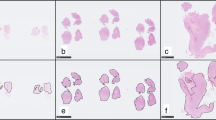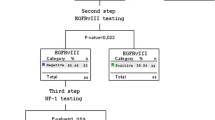Abstract
We performed a systematic immunohistochemical study on 378 brain tumors using 37 antibodies and tissue microarray (TMA) technology. The aim of this study was to find new diagnostic biomarkers using antibodies established in our laboratory. Our TMA consisted of a grid of 1.5-mm cores that were extracted from individual donor blocks. Staining for each antibody was scored using a three-point system. We used hierarchical clustering analysis to interpret these data, which resulted in separation of all the brain tumors into seven groups. Although there were some exceptions, cases with the same histological diagnosis were generally grouped together. We then carried out statistical analyses to find the most useful antibodies for grouping of brain tumors. Ten antibodies [glial fibrillary acidic protein (GFAP), Olig2, vimentin, epithelial membrane antigen (EMA), cytokeratin (AE1/AE3), alpha-internexin, nestin, pinealocytes PP5, aquaporin-4 (AQP4) M13d and AQP4M13e] discriminated between astrocytomas and oligodendroglial tumors. Six antibodies [EMA, AE1/AE3, TUJ1, nestin, neurofilament protein-MH (NF-MH) and perivascular cells GP-1] showed significant differences between high-grade and low-grade gliomas. Our data have revealed new antibodies with potential diagnostic utility (Olig2, PP5, GP-1) and demonstrate that TMA technology is highly useful for evaluating newly established antibodies in brain-tumor research.



Similar content being viewed by others
References
Arai H, Hirato J, Nakazato Y (1998) A novel marker of Schwann cells and myelin of the peripheral nervous system. Pathol Int 48:206–214
Bubendorf L, Kononen J, Koivisto P, Schraml P, Moch H, Gasser TC, Willi N, Mihatsch MJ, Sauter G, Kallioniemi OP (1999) Survey of gene amplifications during prostate cancer progression by high-throughout fluorescence in situ hybridization on tissue microarrays. Cancer Res 59:803–806
DiVito KA, Charette LA, Rimm DL, Camp RL (2004) Long-term preservation of antigenicity on tissue microarrays. Lab Invest 84:1071–1078
Fejzo MS, Slamon DJ (2001) Frozen tumor tissue microarray technology for analysis of tumor RNA, DNA, and proteins. Am J Pathol 159:1645–1650
Fuller CE, Wang H, Zhang W, Fuller GN, Perry A (2002) High-throughput molecular profiling of high-grade astrocytomas: the utility of fluorescence in situ hybridization on tissue microarrays (TMA-FISH). J Neuropathol Exp Neurol 61:1078–1084
Hasselblatt M, Paulus W (2003) Sensitivity and specificity of epithelial membrane antigen staining patterns in ependymomas. Acta Neuropathol (Berl) 106:385–388
Hoos A, Cordon-Cardo C (2001) Tissue microarray profiling of cancer specimens and cell lines: opportunities and limitations. Lab Invest 81:1331–1338
Jeuken JW, von Deimling A, Wesseling P (2004) Molecular pathogenesis of oligodendroglial tumors. J Neurooncol 70:161–181
Katsetos CD, Del Valle L, Geddes JF, Assimakopoulou M, Legido A, Boyd JC, Balin B, Parikh NA, Maraziotis T, de Chadarevian JP, Varakis JN, Matsas R, Spano A, Frankfurter A, Herman MM, Khalili K (2001) Aberrant localization of the neuronal class III beta-tubulin in astrocytomas. Arch Pathol Lab Med 125:613–624
Kay E, O’Grady A, Morgan JM, Wozniak S, Jasani B (2004) Use of tissue microarray for interlaboratory validation of HER2immunocytochemical and FISH testing. J Clin Pathol 57:1140–1144
Kleihues P, Cavenee WK. (2000) World Health Organization classification of tumours, pathology and genetics of tumours of the nervous system. IARC, Lyon
Kononen J, Bubendorf L, Kallioniemi A, Barlund M, Schraml P, Leighton S, Torhorst J, Mihatsch MJ, Sauter G, Kallioniemi OP (1998) Tissue microarrays for high-throughput molecular profiling of tumor specimens. Nat Med 4:844–847
Koperek O, Gelpi E, Birner P, Haberler C, Budka H, Hainfellner JA (2004) Value and limits of immunohistochemistry in differential diagnosis of clear cell primary brain tumors. Acta Neuropathol (Berl) 108:24–30
Kylaniemi M, Koskinen M, Karhunen P, Rantala I, Peltola J, Haapasalo H (2004) A novel frozen brain tissue array technique: immunohistochemical detection of neuronal paraneoplastic autoantibodies. Neuropathol Appl Neurobiol 30:39–45
Liu CL, Prapong W, Natkunam Y, Alizadeh A, Montgomery K, Gilks CB, van de Rijn M (2002) Software tools for high-throughput analysis and archiving of immunohistochemistry staining data obtained with tissue microarrays. Am J Pathol 161:1557–1565
Lusis EA, Chicoine MR, Perry A (2005) High throughput screening of meningioma biomarkers using a tissue microarray. J Neurooncol 73:219–223
Nakazato Y, Ishizeki J, Takahashi K, Yamaguchi H, Kamei T, Mori T (1982) Localization of S-100 protein and glial fibrillary acidic protein-related antigen in pleomorphic adenoma of the salivary glands. Lab Invest 46:621–626
Nakazato Y, Sasaki A, Hirato J, Ishida Y (1987) Monoclonal antibodies which recognize phosphorylated and nonphosphorylated epitopes of neurofilament protein. Biomed Res 8:369–376
Nakazato Y, Hirato J, Sasaki A, Yokoo H, Arai H, Yamane Y, Jyunki S (2002) Differential labeling of the pinealocytes and pineal interstitial cells by a series of monoclonal antibodies to human pineal body. Neuropathology 22:26–33
Neben K, Korshunov A, Benner A, Wrobel G, Hahn M, Kokocinski F, Golanov A, Joos S, Lichter P (2004) Microarray-based screening for molecular markers in medulloblastoma revealed STK15 as independent predictor for survival. Cancer Res 64:3103–3111
Riemenschneider MJ, Koy TH, Reifenberger G (2004) Expression of oligodendrocyte lineage genes in oligodendroglial and astrocytic gliomas. Acta Neuropathol (Berl) 107:277–282
Sallinen SL, Sallinen PK, Haapasalo HK, Helin HJ, Helen PT, Schraml P, Kallioniemi OP, Kononen J (2000) Identification of differentially expressed genes in human gliomas by DNA microarray and tissue chip techniques. Cancer Res 60:6617–6622
Tynninen O, Carpen O, Jaaskelainen J, Paavonen T, Paetau A (2004) Ezrin expression in tissue microarray of primary and recurrent gliomas. Neuropathol Appl Neurobiol 30:472–477
Warth A, Kroger S, Wolburg H (2004) Redistribution of aquaporin-4 in human glioblastoma correlates with loss ofagrin immunoreactivity from brain capillary basal laminae. Acta Neuropathol (Berl) 107:311–318
Warth A, Mittelbronn M, Wolburg H (2005) Redistribution of the water channel protein aquaporin-4 and the K+ channel protein Kir4.1 differs in low- and high-grade human brain tumors. Acta Neuropathol (Berl) 109:418–426
Yamaguchi H (1980) Studies on the immunohistochemical localization of S-100 and glial fibrillary acidic proteins in the rat nervous system and in human brain tumors (in Japanese). No To Shinkei 32:1055–1064
Yamane Y, Mena H, Nakazato Y (2002) Immunohistochemical characterization of pineal parenchymal tumors using novel monoclonal antibodies to the pineal body. Neuropathology 22:66–76
Yokoo H, Nakazato Y (1996) A monoclonal antibody that recognizes a carbohydrate epitope of human protoplasmic astrocytes. Acta Neuropathol (Berl) 91:23–30
Yokoo H, Sasaki A, Hirato J, Nakazato Y (1996) A monoclonal antibody that specifically recognizes a novel mitochondrial protein of human astrocytes. J Neuropathol Exp Neurol 55:716–721
Yokoo H, Sasaki A, Hirato J, Nakazato Y (1998) Immunohistochemical characterization of two novel monoclonal antibodies that recognize human perivascular cells of the central nervous system and macrophage subsets. Pathol Int 48:678–688
Yokoo H, Nobusawa S, Takebayashi H, Ikenaka K, Isoda K, Kamiya M, Sasaki A, Hirato J, Nakazato Y (2004) Anti-human Olig2 antibody as a useful immunohistochemical marker of normal oligodendrocytes and gliomas. Am J Pathol 164:1717–1725
Acknowledgments
We thank Professor K. Takata (Department of Anatomy and Cell Biology, Gunma University Graduate School of Medicine) for providing antibodies (AQP4M13d and AQP4M13e). We also thank Dr. M. Kamiya for helpful advice. The technical assistance of Ms. A. Kumagai and Ms. A. Kodama is gratefully acknowledged. This work was supported in part by a Grant-in-Aid for Scientific Research (B) (no. 15300113) from the Japanese Ministry of Education, Culture, Sports, Science and Technology (to YN).
Author information
Authors and Affiliations
Corresponding author
Rights and permissions
About this article
Cite this article
Ikota, H., Kinjo, S., Yokoo, H. et al. Systematic immunohistochemical profiling of 378 brain tumors with 37 antibodies using tissue microarray technology. Acta Neuropathol 111, 475–482 (2006). https://doi.org/10.1007/s00401-006-0060-1
Received:
Revised:
Accepted:
Published:
Issue Date:
DOI: https://doi.org/10.1007/s00401-006-0060-1




